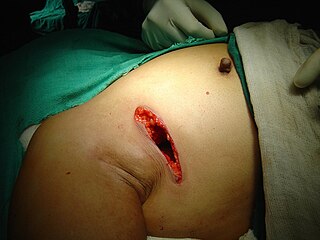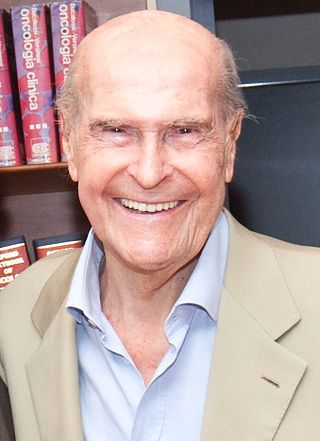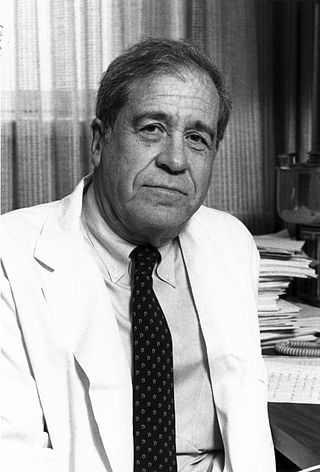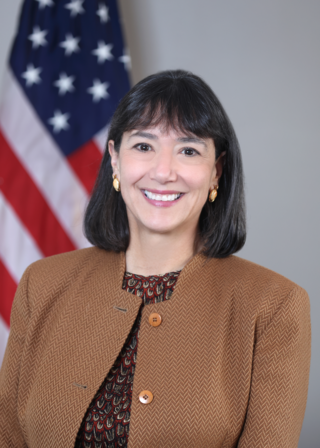Related Research Articles

Mastectomy is the medical term for the surgical removal of one or both breasts, partially or completely. A mastectomy is usually carried out to treat breast cancer. In some cases, women believed to be at high risk of breast cancer have the operation as a preventive measure. Alternatively, some women can choose to have a wide local excision, also known as a lumpectomy, an operation in which a small volume of breast tissue containing the tumor and a surrounding margin of healthy tissue is removed to conserve the breast. Both mastectomy and lumpectomy are referred to as "local therapies" for breast cancer, targeting the area of the tumor, as opposed to systemic therapies, such as chemotherapy, hormonal therapy, or immunotherapy.

Breast cancer is a cancer that develops from breast tissue. Signs of breast cancer may include a lump in the breast, a change in breast shape, dimpling of the skin, milk rejection, fluid coming from the nipple, a newly inverted nipple, or a red or scaly patch of skin. In those with distant spread of the disease, there may be bone pain, swollen lymph nodes, shortness of breath, or yellow skin.

Lumpectomy is a surgical removal of a discrete portion or "lump" of breast tissue, usually in the treatment of a malignant tumor or breast cancer. It is considered a viable breast conservation therapy, as the amount of tissue removed is limited compared to a full-breast mastectomy, and thus may have physical and emotional advantages over more disfiguring treatment. Sometimes a lumpectomy may be used to either confirm or rule out that cancer has actually been detected. A lumpectomy is usually recommended to patients whose cancer has been detected early and who do not have enlarged tumors. Although a lumpectomy is used to allow for most of the breast to remain intact, the procedure may result in adverse affects that can include sensitivity and result in scar tissue, pain, and possible disfiguration of the breast if the lump taken out is significant. According to National Comprehensive Cancer Network guidelines, lumpectomy may be performed for ductal carcinoma in situ (DCIS), invasive ductal carcinoma, or other conditions.
Adjuvant therapy, also known as adjunct therapy, adjuvant care, or augmentation therapy, is a therapy that is given in addition to the primary or initial therapy to maximize its effectiveness. The surgeries and complex treatment regimens used in cancer therapy have led the term to be used mainly to describe adjuvant cancer treatments. An example of such adjuvant therapy is the additional treatment usually given after surgery where all detectable disease has been removed, but where there remains a statistical risk of relapse due to the presence of undetected disease. If known disease is left behind following surgery, then further treatment is not technically adjuvant.

Radical mastectomy is a surgical procedure that treats breast cancer by removing the breast and its underlying chest muscle, and lymph nodes of the axilla (armpit). Breast cancer is the most common cancer among women. During the early twentieth century it was primarily treated by surgery, when the mastectomy was developed. However, with the advancement of technology and surgical skills in recent years, mastectomies have become less invasive. As of 2016, a combination of radiotherapy and breast conserving mastectomy are considered optimal treatment.

Ductal carcinoma in situ (DCIS), also known as intraductal carcinoma, is a pre-cancerous or non-invasive cancerous lesion of the breast. DCIS is classified as Stage 0. It rarely produces symptoms or a breast lump one can feel, typically being detected through screening mammography. It has been diagnosed in a significant percentage of men.

Breast prostheses are breast forms intended to look like breasts. They are often used temporarily or permanently by women after mastectomy or lumpectomy procedures, but may also be used by for aesthetic purposes. There are a number of materials and designs; although, the most common construction is gel in a plastic film meant to feel similar to a person's skin. Prostheses may be purchased at a surgical supply store, pharmacy, custom lingerie shop, or even through private services that come to a person's home. There are many types of ready made breast prostheses including full or standard prostheses, partial prostheses such a shell prostheses, and stick on prostheses. Customized options are also available from specialty shops, which are moulded to fit an individual's chest by taking an impression of the breast(s). The areola and nipple may be replicated as part of the breast form or as separate nipple prosthesis. Both custom made and off-the shelf breast prostheses come in varieties that are designed to either be held in a pocket in a specially designed mastectomy bra or attached to the skin via adhesive or other methods and worn with a standard bra. There are many factors to consider when selecting breast prostheses such as different types and the care they require, insurance coverage, and psychosocial effects.

Umberto Veronesi was an Italian oncologist, physician, scientist and politician, internationally known for his contributions on prevention and treatment of breast cancer throughout a career spanning over fifty years.
Breast cancer management takes different approaches depending on physical and biological characteristics of the disease, as well as the age, over-all health and personal preferences of the patient. Treatment types can be classified into local therapy and systemic treatment. Local therapy is most efficacious in early stage breast cancer, while systemic therapy is generally justified in advanced and metastatic disease, or in diseases with specific phenotypes.

Breast-conserving surgery refers to an operation that aims to remove breast cancer while avoiding a mastectomy. Different forms of this operation include: lumpectomy (tylectomy), wide local excision, segmental resection, and quadrantectomy. Breast-conserving surgery has been increasingly accepted as an alternative to mastectomy in specific patients, as it provides tumor removal while maintaining an acceptable cosmetic outcome. This page reviews the history of this operation, important considerations in decision making and patient selection, and the emerging field of oncoplastic breast conservation surgery.

Oncology is a branch of medicine that deals with the study, treatment, diagnosis, and prevention of cancer. A medical professional who practices oncology is an oncologist. The name's etymological origin is the Greek word ὄγκος (ónkos), meaning "tumor", "volume" or "mass". Oncology is concerned with:

Bernard Fisher was an American surgeon and a pioneer in the biology and treatment of breast cancer. He was a native of Pittsburgh. He was Chairman of the National Surgical Adjuvant Breast Project at the University of Pittsburgh School of Medicine. His work established definitively that early-stage breast cancer could be more effectively treated by lumpectomy, in combination with radiation therapy, chemotherapy, and/or hormonal therapy, than by radical mastectomy.
Mildred Vera Peters, OC was a Canadian oncologist and clinical investigator.
Eleanor D. Montague was an American radiologist and educator who established breast-conserving therapy in the United States and improved radiation therapy techniques. She became a member of the Texas Women's Hall of Fame in 1993.
Laura Esserman is a surgeon and breast cancer oncology specialist. She is the director of the Carol Franc Buck Breast Care Center at the University of California, San Francisco School of Medicine. She leads the I-SPY trials, Athena Breast Health Network and the WISDOM study. Esserman is an inductee in the Giants of Cancer Care, 2018, for Cancer Diagnostics and the "less is more" approach. She performs live in the show "Audacity" which she co-created. She is also known as the "singing surgeon" for singing to her patients as they go under anesthesia.

Sandra M. Swain is an American oncologist, breast cancer specialist and clinical translational researcher. She is currently a professor of Medicine at the Georgetown University School of Medicine and the Associate Dean for Research Development at Georgetown University Medical Center (GUMC) and MedStar Health as well as an adjunct professor of Medicine at the F. Edward Hébert School of Medicine of the Uniformed Services University of Health Sciences. She is also a past President of the American Society of Clinical Oncology (ASCO), serving from 2012 through 2013.
Sonja Eva Singletary was an American surgeon who specialized in the care of breast cancer. She was a faculty member at the University of Texas MD Anderson Cancer Center and a past president of the Society of Surgical Oncology.
Anne Louise Rosenberg is an American surgical oncologist retired from practice in Cherry Hill, New Jersey.

Monica Bertagnolli is an American surgical oncologist and the 17th director of the National Institutes of Health. She previously served as the 16th director of the National Cancer Institute (NCI). Prior to her governmental positions, she worked at Brigham and Women's Hospital and Dana–Farber Cancer Institute and was the Richard E. Wilson Professor of Surgery at Harvard Medical School.
Lisa J. M. Caldon is a British professor and clinical lecturer specialising in oncology. In her 20 year career, Caldon has published some 20 papers in the field of medicine. These have appeared in some of the top medical and peer-reviewed journals in Britain and abroad, including Medical Education, the European Journal of Cancer, the British Journal of Surgery, Patient Education and Counseling, Psycho-Oncology, Future Oncology, BMC Medical Informatics and Decision Making, and The Lancet Oncology. Caldon has worked at The University of Sheffield and with Cancer Research UK.
References
- 1 2 3 "Jewish General Hospital » Dr. Richard Margolese: A warrior in the battle against breast cancer". jgh.ca. Retrieved 2015-06-23.
- ↑ "Guideline 3: Mastectomy or lumpectomy? The choice of operation for clinical stages I and II breast cancer [Supplement, CMAJ - Feb. 10, 1998]". collectionscanada.ca. Retrieved 2015-06-23.
- 1 2 "McGill Reporter". reporter-archive.mcgill.ca. Retrieved 2015-06-23.
- ↑ Fisher, Bernard; Bauer, Madeline; Margolese, Richard; Poisson, Roger; Pilch, Yosef; Redmond, Carol; Fisher, Edwin; Wolmark, Norman; Deutsch, Melvin (March 14, 1985). "Five-Year Results of a Randomized Clinical Trial Comparing Total Mastectomy and Segmental Mastectomy with or without Radiation in the Treatment of Breast Cancer". New England Journal of Medicine. 312 (11): 665–673. doi:10.1056/NEJM198503143121101. ISSN 0028-4793. PMID 3883167.
- ↑ Fisher, Bernard; Anderson, Stewart; Bryant, John; Margolese, Richard G.; Deutsch, Melvin; Fisher, Edwin R.; Jeong, Jong-Hyeon; Wolmark, Norman (October 17, 2002). "Twenty-Year Follow-up of a Randomized Trial Comparing Total Mastectomy, Lumpectomy, and Lumpectomy plus Irradiation for the Treatment of Invasive Breast Cancer". New England Journal of Medicine. 347 (16): 1233–1241. doi: 10.1056/NEJMoa022152 . ISSN 0028-4793. PMID 12393820.
- ↑ "Potential Practice Change in Management of DCIS".
- 1 2 "Order of Canada". archive.gg.ca. Retrieved 2015-06-23.
- ↑ "Anastrozole May Be 'Preferable Option' to Tamoxifen for Treatment of DCIS | ASCO Annual Meeting". am.asco.org. Retrieved 2015-06-23.
- ↑ "Top Takeaways from ASCO: Breast Cancer". www.healio.com. Retrieved 2015-06-23.
- ↑ Margolese, Richard G.; Fisher, Bernard; Hortobagyi, Gabriel N.; Bloomer, William D. (2000). "Neoplasms of the Breast".
{{cite journal}}: Cite journal requires|journal=(help) - ↑ Breast Cancer Collaborative Management. CRC Press. 1988-04-01. ISBN 9780873711067.
- ↑ "Academic.Research.microsoft.com". Academic.Research.microsoft.com. Microsoft. Retrieved 20 June 2015.
- ↑ Margolese, Richard G. (1974). A doctor's eat-hearty guide for good health and long life. Parker Pub. Co. ISBN 9780132163743.
- ↑ "ISBN 9780132163743 | A Doctor's Eat-Hearty Guide for Good Health and Long Life". www.isbnsearch.org. Retrieved 2015-06-23.
- ↑ "Research awards - Canadian Cancer Society". www.cancer.ca. Retrieved 2015-06-23.
- 1 2 Swaine, Ronald. "LDI - Margolese, Richard". www.ladydavis.ca. Retrieved 2015-06-23.
- ↑ "News | Department of Oncology, McGill University". www.medicine.mcgill.ca. Retrieved 2015-06-23.